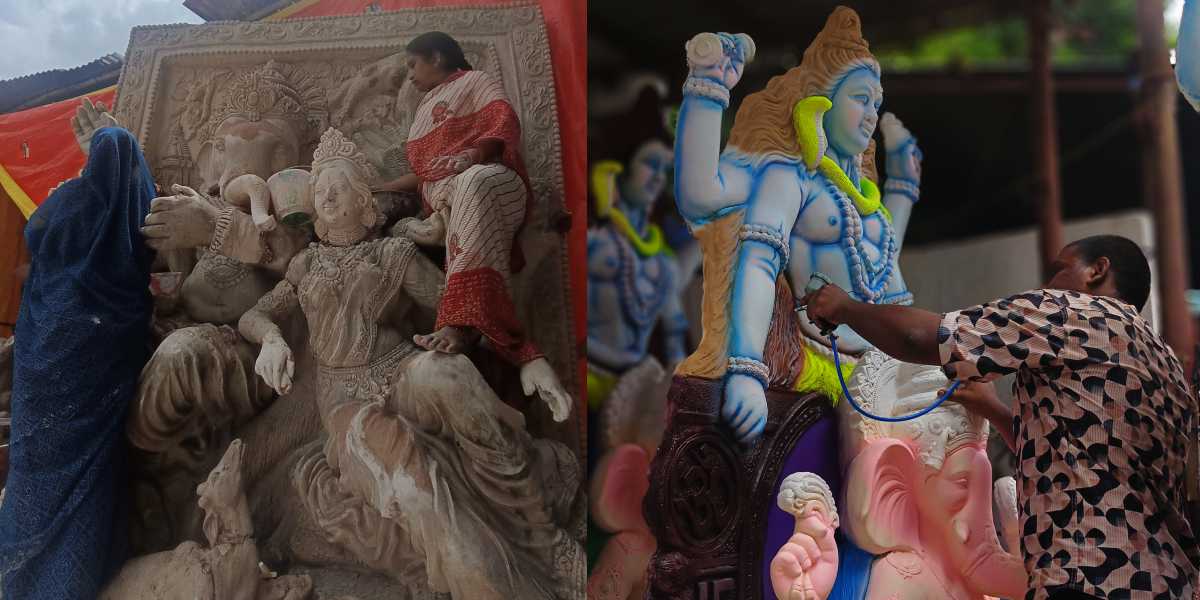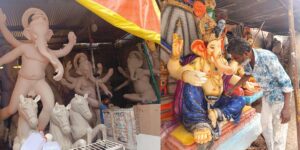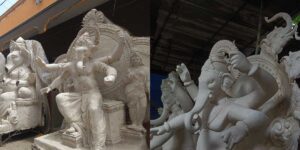In Dhoolpet, idol-making is not merely a business—it’s a tradition passed through generations, sharpened each year by memory and hand.
Published Aug 06, 2025 | 8:00 AM ⚊ Updated Aug 06, 2025 | 8:00 AM

Synopsis: Every idol in Dhoolpet begins with raw materials sourced from across the country. Plaster of paris arrives from Nagaur in Rajasthan. Kata—a coarse, fibrous material made from coconut husk and used for structural reinforcement comes from as far as Kerala and Visakhapatnam. Some workshops opt for sturdier iron frameworks, with most of the metal procured from Hyderabad’s Rani Gunj market.
In the heart of Hyderabad’s Old City, the narrow lanes of Dhoolpet come alive every year with a quiet sense of anticipation. The neighbourhood, known for its bootlegging past, shifts into something altogether different during the festive season. There’s a rhythm in the way people move, a hush in the air just before it bursts into a colourful celebration.
Behind the Jali Hanuman Temple, the lanes begin to change character—one by one, they reveal rows of intricately made Ganesh idols, standing in all their monsoon-proof shades, some wrapped carefully in plastic, others towering like freshly painted guardians of the street.
An auto-rickshaw driver’s words echo in the backdrop —“Ye log prachin kala ke pujari hai” (“These people are worshippers of ancient art”). The quote feels perfectly timed as the temple gate comes into view, signalling the start of a labyrinthine walk through devotion and craftsmanship. The mohalla has a peculiar charm: a devotional quietness that’s alive with movement.
A group of women passes by, bright tikkas glowing on their foreheads. From every corner, the idols catch your eye—there’s no escaping their gaze. What surprises you most is the cleanliness. This place, dusty and timeworn as it is, feels more orderly and cared for than some of Hyderabad’s most popular tourist spots.
The air carries a heavy blend of plaster of paris and wet clay, earthy and chemical at once. You can almost feel the craft settling into your skin. Old homes with carved windows and faded murals look down on the scene like time-travellers, bearing witness to decades of seasonal metamorphosis.
In Dhoolpet, idol-making is not merely a business—it’s a tradition passed through generations, sharpened each year by memory and hand.
Inside the workshops, artisans work in silence, smoothing rough edges and layering colours even late into the night. Their hands know these forms better than their own reflections. From palm-sized idols meant for home altars to grand 20-foot Ganeshas that block entire streets, Dhoolpet supplies statues far and wide—through Telangana, into Karnataka, Andhra Pradesh, Gujarat, and even Maharashtra.
Such is the fame of this neighbourhood that its Ganesh idols are often preferred over local ones—even in the land of Lalbaug.
“The speciality of Dhoolpet lies in its durability and colour,” says Laddu Singh, as he adjusts the nozzle of his spray gun, his hands coated in fine plaster of paris dust. He runs a family workshop alongside his father and brother, a legacy passed down through generations. “We use both plaster of paris and soil for the base and finishing,” he explains, nodding towards a half-finished idol that glistens under the workshop light.
Since the COVID-19 pandemic, environmental concerns around immersion practices have led to tighter regulations from the Pollution Control Board, especially regarding the use of plaster of paris. Singh, however, insists that their methods are more eco-conscious. “Our murthis are layered thinly. We don’t use 100% plaster of paris like they do in Maharashtra; we use clay to shape the design.”
For Laddu-ji, this craft is more than a seasonal trade—it’s a calling. Though he holds a day job at a multinational company, his heart lies in the workshop where his journey began as a young boy. One of his most memorable creations was inspired by the VFX-heavy portrayal of Shiva in the Chiranjeevi film Anji.
“We designed an Ardhanarishwar backdrop for Ganesha that year,” he recalls with pride—a fusion of cinematic influence and devotional artistry.
The pandemic dealt a heavy blow to Dhoolpet.
In 2020, production came to a sudden standstill as orders dried up almost overnight. “It was a pause no one expected,” recalls veteran artisan Cheta Singh, who has been in the trade for 45 years. His family’s workshop, he says, can be traced back at least a century, possibly even 150 years.
With transport restrictions and local lockdowns, new hubs like Nagole and Uppal began crafting their own idols, chipping away at Dhoolpet’s long-held dominance. Yet, for many artisans here, giving up wasn’t an option. Brothers Surender and Subhash Singh—who once constructed a towering 28-foot Ganesh idol—chose to continue despite dwindling demand.
Last year, they experimented with a Mahabharata-themed murthi, though it didn’t receive the attention they hoped for. This year, undeterred, they’ve shifted focus to Vishnu’s Anantsajya and Vishwaroop avatars.
There’s a quiet faith that keeps the community going. “We do think of profit,” says workshop owner Akash Singh, “but we don’t set a fixed investment for Ganpati. If my lord blesses the work, the profit can be endless.”
Almost every artisan in Dhoolpet shares the surname Singh and traces their roots to the Lodh Rajput community. Their ancestors migrated generations ago from Uttar Pradesh and Bundelkhand, spread over Madhya Pradesh and Uttar Pradesh, many say during the battle between Aurangzeb and Quli Qutub Shah. Hyderabad became their home, and idol-making, their livelihood, especially after the loss of agricultural land.
What started as survival slowly evolved into an art form—and for many, a deep source of pride.
Today, Dhoolpet’s workforce is a blend of local families and seasonal labourers drawn from different parts of India. Bengali workers bring their finesse in clay detailing, while craftsmen from Maharashtra contribute their own stylistic touches.
The area is a hive of activity—not just during Ganesh Chaturthi, but all year round. Outside the festive season, many artisans turn to making kites or sweets. Cheta Singh, for example, sells more kites than idols during the off-season, sustaining his family through the months when the gods are silent.
Every idol in Dhoolpet begins with raw materials sourced from across the country.

Every idol in Dhoolpet begins with raw materials sourced from across the country.(Udita Purkait/South First)
Plaster of paris arrives from Nagaur in Rajasthan. Kata—a coarse, fibrous material made from coconut husk and used for structural reinforcement comes from as far as Kerala and Visakhapatnam. Some workshops opt for sturdier iron frameworks, with most of the metal procured from Hyderabad’s Rani Gunj market.
The finishing touches involve an intricate mix of clay work and fiber DIY additions. Marathi-style idols, known for their elegance, are dressed in dhotis and shawls made from lycra fabric imported from Surat. The painting process is equally layered—large dispensers apply the base coats, while handheld spray guns are used for fine detailing and facial expressions.
A 20-foot idol can require as many as 30 sacks of plaster of paris (each weighing 25 kg) and between 15 to 20 litres of water, depending on the weather and intricacy. It’s labour-intensive work, driven by the hands of seasoned artisans like Renuka Devi, who has spent over a decade working in Cheta Singh’s workshop, or Jaipal Singh’s team of Bihari labourers—some of whom have been in the trade for over 20 years.
On average, each workshop sells about 100 idols a year. The larger pieces can cost anywhere between ₹70,000 and ₹80,000, depending on the size, materials, and level of detailing.
As environmental awareness rises, the use of plaster of paris in idol-making has come under increasing scrutiny. Some workshop owners defend it passionately, insisting that thin-layered plaster of paris idols dissolve within 48 hours and even “purify the water.” But environmental experts strongly contest these claims, warning that plaster of paris can cause exothermic reactions when submerged and releases harmful compounds that affect aquatic life.

Since the pandemic, environmental concerns have led to stricter Pollution Control Board rules on POP use during immersions. (Udita Purkait/South First)
Health concerns also haunt the workshop floors. Plaster of paris dust is known to cause skin irritation, and long-term exposure can lead to serious respiratory issues among workers—especially those without protective gear.
Despite these concerns, demand for plaster of paris idols remains robust. Residential colonies and community groups often place bulk orders for the tallest and most elaborate murthis, while smaller shops cater to households looking for modest two to three-foot statues.
The industry also remains largely male-dominated. Women like Renuka Devi are rare exceptions in this space, and in many workshops, women are either not involved or explicitly discouraged from participating.
Much of the urgency around eco-friendliness is tied to the deteriorating water quality of Hyderabad’s iconic Hussain Sagar Lake. Years of immersion ceremonies, combined with untreated industrial sewage, have significantly worsened pollution levels. As a result, municipal authorities and pollution control boards have begun enforcing stricter guidelines—pushing for clay idols and more sustainable practices.
For all its challenges, Dhoolpet’s legacy endures. The township’s artisans have shaped Telangana’s Ganesh Chaturthi celebrations for generations.
Their skill, dedication, and artistry continue to define the festival’s visual grandeur. Walking through Dhoolpet’s lanes during the season, it’s clear that for these families, making Ganesh idols is not just work—it’s heritage, devotion, and survival intertwined.
Ganesh Chaturthi, this year, is on 27 August. Ganesh Visarjan will be on 6 September, marking the end of the celebration.
(Edited by Majnu Babu).
